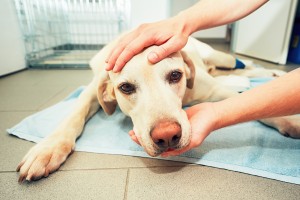What is Minimally Invasive Surgery?

Minimally invasive surgery (MIS) refers to surgical procedures that are performed through one or multiple small incisions instead of one large incision via the use of specialized instrumentation, cameras, and video displays. The benefits of MIS are numerous and include reduced postoperative pain, preservation of patient immune status, and faster recovery. Minimally invasive surgery has proven to have tremendous diagnostic and therapeutic value when it comes to evaluating and treating disease in the thoracic cavity (thoracoscopy), abdominal cavity (laparoscopy), and joints (arthroscopy) of companion animals.
The term “endoscopy“ refers to the use of miniature cameras and instruments to diagnose and treat diseases throughout the body. Arthroscopy, laparoscopy and thoracoscopy are specific forms of endoscopy.
Minimally Invasive Surgical Procedures for Pets
Arthroscopic Procedures:
Arthroscopy incorporates the use of miniature orthopedic cameras (endoscopy) and instruments to diagnose and treat joint diseases. Arthroscopy is an orthopedic-specific form of endoscopy.
- Shoulder osteochondritis dissecans (OCD), biceps tenosynovitis
- Elbow OCD, fragmented medial coronoid process, ununited anconeal process
- Stifle cranial cruciate ligament tears, meniscal tears
Laparoscopic or Laparoscopic-assisted Procedures:
Laparoscopy incorporates the use of miniature orthopedic cameras (endoscopy) and instruments to diagnose and treat soft tissue.
- Liver biopsy
- Intestinal biopsy
- Ovariectomy
- Cryptochidectomy
- Cholecystectomy
Thoracoscopic or thoracoscopic-assisted procedures
Thoracoscopy is a minimally invasive technique that allows our surgeons to visualize the chest cavity without the need to separate the ribs.
- Lung or pleural biopsy
- Lung lobectomy
- pericardal window and subtotal pericardiectomy
For more information on these procedures, or any surgical questions you may have, you can connect with us or your family veterinarian. At Ethos Veterinary Health hospitals, our teams work together with your family veterinarian to find the best medical treatment plans for both you and your pet.